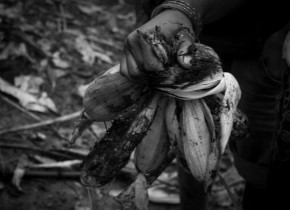Disaster on Poverty
If someone asks with me a photo of disaster, I always go to explore the folder of the Fire Disaster in Poverty in my hard disk because these photos are my first photos of disaster that I took in the beginning of my photojournalism career. This is the first time in my life which made me in confusion whether I should act as a social person in disaster or should I capture the moments of disaster as a witnesses.
The images and the disaster situation of the fires disaster have made a permanent memory in my mind. I was in an assignment to take the photos of shifting Cultivation of Chepang Community in Jogimara Village Development committee of Dhading district of Nepal. It was early foggy morning of November 15, 2009. I was sleeping inside my sleeping bag in a house of Chepang, one of the most backward indigenous ethnic groups of Nepal. Some women shouted in neighbor “Fire! Fire! Help! Help!
I quickly got out of sleeping bag and rushed towards the shout. I saw a house on fire and some children and women were trying to extinguish it but helpless. One of the women shouted “water, bring water! There was no water until the moments when fire ate half of house roof that was made up of straw. Fire showed its maximum strength in the poverty where there is no fire brigade. Even, the only common water supply tap in the village was also without water supply. Later I knew that the only drinking water supply in the village is irregular. How can villager take help of water to extinguish disaster fire, where there is no sufficient supply of water to drink? I try to help too but I found myself helpless, because there was not weapon to fight against this cruel fire. Suddenly one of the villagers brought pipe with water supply but it was late and the water supply was too small to fight against the mature fire. Until this moment I hadn’t took out my camera but when the fire was out of control I decided to capture this tragedy. Most of the villagers were fighting against the fire.
One thing, I noticed that they were trying to save the stock maize, which was inside the house, from fire by taking the great risk. The house owner, Sher Bahadur Chepang, who built this house alone in 6 months just three months ago, was taking biggest risk with fire to save the stock maize which is the main food for his two sons and wife, who was crying by the side of the burning house with one of her son.
At last they were not able to save their house but they were only able to save most of the maize stock. Later my friend Kamal Aryal, who is specialist in Shifting Cultivation in Nepal, explained me the importance of maize in the life of Chepang.
Most of the Chepang people in Nepal don’t have registered land and they have been practicing shifting cultivation around their village in the slope area since many generations. It is not possible to produce rice in shifting cultivation and Chepang people can’t afford rice because they don’t have other source of income except to depend on the shifting cultivation that their forefather taught them to practice. Maize is the main food produced from shifting cultivation with great hard work and is the only staple food of Chepang. Maize is produced once a year from shifting cultivation and which is only enough to serve a chepang family for 4 to 6 months a year. For rest of the months, Chepang people heavily depend on wild and uncultivated foods and or migrate to city areas as low paid labor.
Now I realized why Sher Bahadur Chepang was fighting with the fire not to save cloths and utensils but to save Maize.
Click on the photos for slideshow
- 1
- 2
- 3
- 4
- 5
- 6
- 7
- 8
- 9
- 10
- 11
- 12











